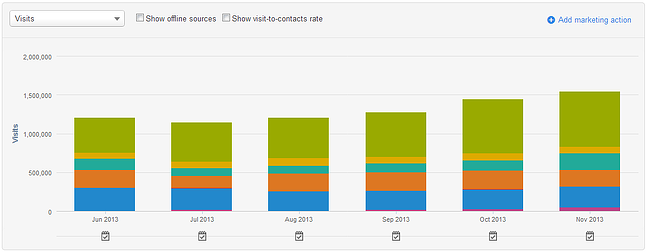Managing a blog is hard work. For most of us, we are too busy to do it ourselves, but for those of us that are doing blogging and creating content, here is how you can figure out if your blog is working or not.
9 Blogging KPIs You Should Be Tracking For Success
1) Overall Website Visits
How many visits does your website actually get? Take a look at your overall website as well as your blog rake in a given period of time. Google Analytics is a great resource if you are already using it. Tracking this on a monthly basis will give you a good sense of whether you’re growing traffic to your blog over time and insight into monthly trends. For example, What months is your traffic heavier, or what blogs were popular? What traffic sources drove people to read your blogs and what actions did people take after reading your blog.
HubSpot customers can easily track this metric using the Sources tool (pictured below). Google Analytics is another option.

2) Number of Posts Published
Tracking the sheer number of blog posts published in a given time period is easy and can give you an idea of your consistency with posting. Are you not posting enough, or are you posting too much? (yes that is a thing) Make sure you are posting consistently and with purpose. but don’t annoy people by posting too much.
You can easily track this from the blogging platform you are using. Such as WordPress.
3) Top Viewed Blog Posts
All Blogs have topics that drive better traffic than others. Which posts are your best traffic drivers? Identifying these posts can help you analyze the topics, types, and formats of blog posts that are bringing you the best return. Having a traffic problem? Check out our Managed Blogging for help.
HubSpot customers can easily track this metric using the Sources tool, Google Analytics is another option as well as WordPress.
4) Average Inbound Links per Post
Are you creating content worth linking to? Inbound links are extremely valuable currency in the land of search engines. It indicates to search engines that your content is valuable to others and worth ranking well in search results. Keep track of your average inbound links so you can keep tabs on the quality of your content (more important than ever in the eyes of Google) and thus, your inbound links’ impact on your search authority.
There are many different tools for tracking links. MOZ is one that we use as well as Ahrefs. Moz is a free account that also has a chrome extension to make finding this out fast and easy.
5) Average Comments per Post
Very often I hear that the number of comments a post gets is mainly a vanity metric. However, I disagree. Tracking engagement and sentiment among your readers definitely has its place. Use this to gauge your audience’s reaction to your content and how involved your community is. If engagement is low, experiment with ways to encourage it: Pose questions in your content, try new types of content that might elicit a response, and get involved in the discussion in the comments of your posts as well. Another thing you might find by checking and monitoring comments is leads. And that is something we can all use.
It’s probably best to just use whatever platform you are using to post blogs to track this.
6) Social Shares per Post
While also somewhat of a vanity metric, the number of social shares per post will give you a good sense of which types of content perform well in social media — and in which social networks in particular. This can inform decisions about which types of content to promote in social (and on what networks specifically) for the best ROI. You might find that content that performs well on Twitter, for instance, does very poorly in a social network like LinkedIn. Use these insights to improve your social media marketing strategy as it relates to blog promotion.
7) Conversion Rate
This is likely one of the most important metrics to track. Conversion is the entire season you are even writing a blog. In fact without it, your kind of waisting time. Here’s an online calculator for calculating conversion rates. All of the being said, conversion can come in different forms. Are you looking to simply increase traffic, do you want better rankings, or is it all about leads? Maybe it’s all of those. Conversion can be hard to track, you can use the calculator, you can look at all the metrics in the world, but the most important one is, are leads and revenue up since you started and are they continuing to climb?
8) Active RSS Subscribers
How many people are subscribed to your blog via RSS? More importantly, how many of those subscribers actively check your feed? The number of active subscribers you have is a great metric for evaluating how many loyal, dedicated readers you’ve attracted and retained. It’s also a great indicator of your blog’s stickiness. Do people just visit your blog once, never to return? Or do they love your content so much they want to keep coming back for more? Generating more and more of the latter type of visitor means you’re growing a group of content evangelists who are more likely to share your content, sing your praises, and expand your reach to more potential readers.
9) Email Subscribers
Last, but definitely not least, your email subscribers. This one a super simple. Are they increasing and how many of your subscribers read and interact with the emails you send out.
If you need help with blogging, just let us know. We have solutions for any budget and any industry.




Leave A Comment
You must be logged in to post a comment.